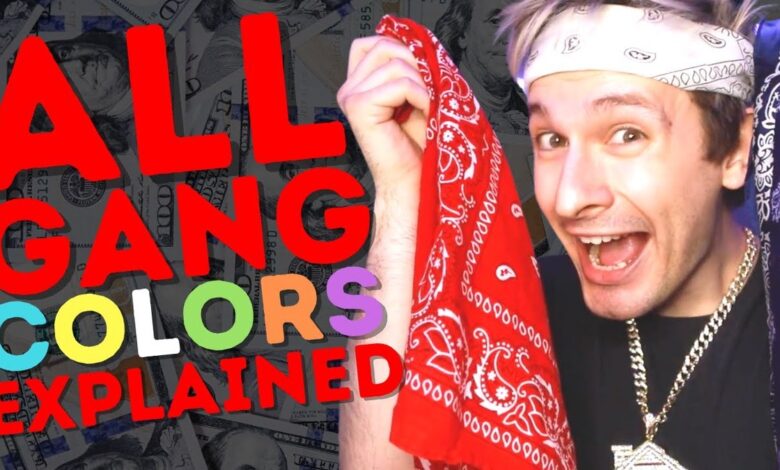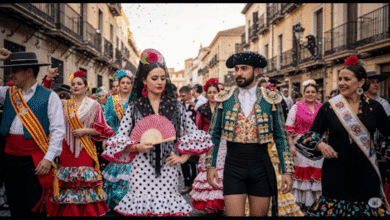Blood Bandana: Meaning, History, and Cultural Relevance

The term “blood bandana” holds strong visual, cultural, and symbolic meaning—especially in the context of American urban culture, street fashion, and gang symbolism. Recognizable by its vibrant red color and paisley print, the blood bandana has carried different interpretations over time, ranging from street identity and rebellion to fashion statements and music symbolism.
In this article, we’ll explore what the blood bandana signifies, its origins, and how it is viewed in different spaces today.
What Is a Blood Bandana?
A blood bandana is typically a red-colored bandana featuring a white paisley or similar pattern. While a bandana on its own is just a piece of cloth worn for functional or decorative purposes, the red bandana—especially when referred to as a “blood bandana”—often holds deeper meaning.
The term “blood” in this context is strongly linked to the Bloods, a well-known street gang that originated in Los Angeles in the 1970s. Members of this gang were known to wear red bandanas as a symbol of affiliation and identity. The bandana served as a quick and visible way to mark loyalty, territory, and brotherhood.
Origins and Gang Association
The Bloods gang was formed in response to rival groups like the Crips, who adopted blue as their identifying color. As a counter-symbol, Bloods chose red, which extended into clothing, graffiti, and most iconically—the red bandana.
Over time, the blood bandana evolved from a piece of gang identification into something far more complex. It became a cultural symbol—both feared and respected—especially as hip-hop artists and pop culture figures began to incorporate it into their image, lyrics, and performances.
However, wearing a red bandana in certain neighborhoods or cities can still carry serious consequences, especially in places where gang activity remains active.
Proliferation in Hip-Hop and Streetwear
During the late 1990s and early 2000s, many rappers and musicians affiliated with the Bloods wore red bandanas in videos, on stage, and in promotional photos. Artists like The Game, Lil Wayne, and Jim Jones have been seen wearing them, often as a sign of pride, background, or representation.
From there, the red bandana entered streetwear fashion, showing up on:
- T-shirts
- Sneakers
- Caps
- Face masks
- Accessories
For some, it’s a fashion statement with bold visual impact. For others, it’s a nod to personal roots or admiration for hip-hop culture.
Cultural Caution: What You Need to Know
If you’re considering wearing a red bandana or styling yourself with one, it’s crucial to understand the cultural and social context. While it may appear harmless, in some urban areas, a red bandana is still seen as gang-related attire, and wearing it could put someone at risk—especially if they unknowingly wear it in the wrong setting.
Here are a few tips:
- Know the history behind the look.
- Avoid wearing it in areas with active gang presence.
- If you’re using it for fashion purposes, consider the context—concerts, music videos, or stylized photoshoots are more appropriate than public display in unfamiliar neighborhoods.
Symbolism Beyond Gangs
Interestingly, the blood bandana has also been reclaimed or reimagined in new ways:
- Protest movements have used red bandanas as symbols of resistance or identity.
- Fashion designers have embraced the paisley pattern and red palette in high-end collections.
- Artists and photographers use the symbol to explore themes of youth, loyalty, identity, and survival.
So while the original symbolism remains potent, the red bandana’s meaning has evolved, reflecting broader cultural narratives beyond gang affiliations.
FAQs About Blood Bandana
Q1: What does a blood bandana mean?
A: Traditionally, a blood bandana is associated with the Bloods gang and symbolizes gang affiliation, especially in American urban areas. In other contexts, it may simply reflect fashion or cultural expression.
Q2: Is it dangerous to wear a red bandana?
A: It can be risky in some areas, especially cities where gang activity is present. If you’re not part of that culture or community, it’s advised to avoid wearing red or blue bandanas in public unless you understand the local context.
Q3: Is a red bandana only used by gang members?
A: No. While the red bandana has a strong association with the Bloods, it’s also used in music videos, fashion, streetwear, and art. Context matters—it’s not inherently gang-related outside of specific environments.
Q4: What’s the difference between a blood bandana and a regular red bandana?
A: Technically, they are the same object—a red bandana. The term “blood bandana” is used when referring to its symbolic or cultural meaning, particularly in gang-related or hip-hop contexts.
Q5: Can I wear a red bandana as a fashion statement?
A: Yes—but do so with awareness. In many settings, it’s just another stylish accessory. However, if you’re in an area where it might be misunderstood, opt for different colors or styles to avoid misinterpretation.
Final Thoughts
The blood bandana is a powerful cultural symbol—one that has evolved from a gang identifier into a broader representation of music, fashion, and expression. Whether worn in defiance, loyalty, style, or art, it’s essential to understand the weight of its history and how it might be interpreted.
If you choose to wear one, do so respectfully, informed, and with awareness of the context in which it appears.




